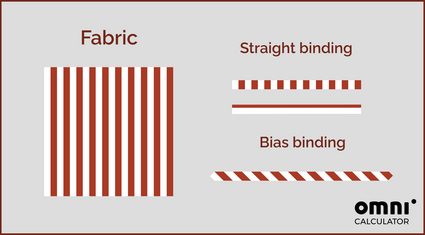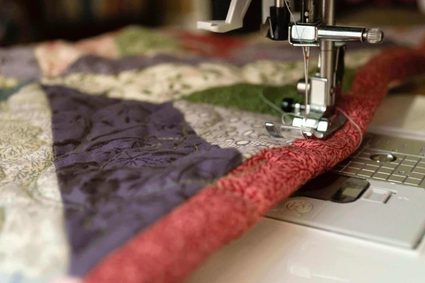Quilt Binding Calculator
This quilt binding calculator is a tool that will help you estimate how much binding fabric you need to finish your quilt smoothly.
Binding is the perfect way to finish a sewing project. It's the most elegant way to hide the raw edges of a skirt or a dress. For quilters, covering the edges of the quilt sandwich with binding is the mandatory and final step.
Keep reading to learn what is the best quilt binding width and what are different types of binding. We will also explain how to make bias binding for a quilt.
Binding strips
You could buy a binding tape, but what better way to put the last personal touch to your quilt than to make your own? But how to make binding for a quilt?
Generally, to make binding, you cut long strips of not too stretchy fabric and sew them together to create a long tape. Binding is characterized by two criteria: how it's cut and how it's folded.
You can cut the fabric in two ways. If you cut the binding strips along the fabric's yarn direction, they create straight (cross-grain) binding. If they're cut along the bias of the material, it produces bias binding. Which one is better? Bias binding arranges nicely on curved edges. It also wears better than straight binding. Other than that, before choosing the binding type, you should think about the look of the design on the fabric when all you can see is a thin strip.

If you need binding for a quilt, you will have to create a double-fold binding. It means that you will have to fold it in three places. Another type of binding – single fold binding – is intended for clothes.
While you are in a creative frame of mind, take a look at our curtain panel calculator for information on how to measure and sew curtain panels.
Binding calculations
How long should your binding be? To find out, measure your quilt, and calculate its perimeter.
2 × length of quilt + 2 × width of quilt = perimeter
Add 10 inches (25.4 cm) to the perimeter. You will need this overage when joining the binding strips and to join the ends of the binding tape on the quilt. The length of the binding tape is the sum of the quilt perimeter and the overage.
perimeter + 10" = length of binding
Next, choose the binding type:
-
If you picked straight binding, measure the edge of the binding fabric along which you will cut the straps.
length of binding / width of material = amount of strapsNow you know how many straps you need. Lastly, figure out how wide do you need them to be. What is the best quilt binding width? Usually, quilters choose to cut their binding strips between 2 and 2.5 inches. That way, around 0.25 inches of binding on each side of the quilt is visible.
amount of straps × width of straps = length of fabricThe result is the fabric's length necessary to create a straight binding for your quilt.

-
If you want bias binding the calculations are a bit trickier.
To create bias binding, you need a square or a rectangle of fabric. First, estimate the area of required bias tape:
length of binding × width of straps = area of binding fabric
The result is the minimum fabric area you will need to create the binding. Why minimum? Because there are many ways to cut fabric to make bias tape. The most efficient method of cutting is presented in this video:
If you want to cut the binding out of a square, calculate the side of that square with this equation (feel free to use the square root calculator):
square's side = √(area of binding fabric)
If you prefer to cut from a rectangle, estimate its length and width by the size of fabric you own and the required area. To do that, you can use our area of a rectangle calculator.
How to use the quilt binding calculator?
-
First, measure your quilt and input the quilt's width and length.
-
Choose the width of the binding straps or input a custom width.
💡 Consider the way you will attach the binding to your quilt before choosing the strap's width. It may have an impact on the final width of the visible binding.
-
Select the type of binding: straight tape or bias tape.
-
Input the width of fabric you will make the binding out of.
- If you're planning to make a straight binding, measure the edge along which you will cut the straps.
- If you want bias binding, measure the shorter edge of the fabric.
-
Read the result, and:
- Get to cutting and sewing if you chose straight binding; or
- If you chose bias tape, consider the best option for fabric shape and create the binding.
We hope you enjoyed our quilt binding calculator! Before you go, we have two other calculators that can help you with sewing quilts - hexagon quilt calculator, and quilt calculator